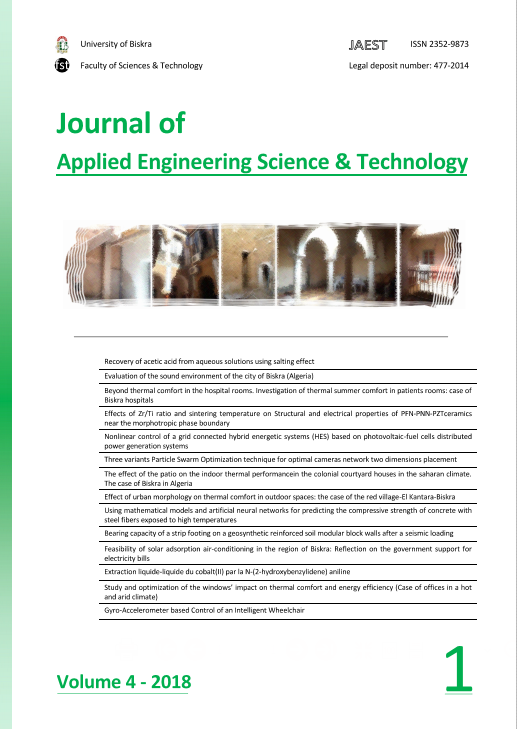DOI:
https://doi.org/10.69717/jaest.v4.i1.62Keywords:
Concrete, Compressive strength, Porosity, Mathematical method, Artificial neural networks, Ultrasonic pulse velocityAbstract
In this study mathematical methods and artificial neural network (ANN) model are used to predict the compressive strength of concrete with steel fibers exposed at high temperatures. The data used in the models construction were obtained from laboratory experiments. The compressive strength was experimentally determined for specimens containing three volume fractions of steel fibers 0.19%,0.25%, 0.5% were used and two different water/cement ratios (w/c of 0.35 and 0.45). Specimens were subjected to various heating-cooling cycles from the room temperature to 200, 400, and 600°C. The inputs models of ANN were temperature, w/c, percentage of porosity, ultrasonic pulse velocity; percentage of steel fibers and percentage superplasticizer, the output was the compressive strength of concrete. Four mathematical models were development to predict the compressive strength. Three mathematical models including a number of functions to express the strength-porosity relationship, and other model used to establish the relationships between strength and ultrasonic pulse velocity. Mathematical methods, artificial neural network and their results were evaluated and compared. The results show that ANN has good potential to be used as a tool for predicting the compressive strength of concrete with steel fibers exposed to high temperatures.
Downloads
Downloads
Published
Issue
Section
License

This work is licensed under a Creative Commons Attribution-NonCommercial 4.0 International License.
How to Cite
Most read articles by the same author(s)
- Hicham Mokhbi, Mekki Mellas, Abdelhak Mabrouki, Jean‐Michel Pereira, Numerical study of a vertical pullout capacity of strip anchor plate on a frictional soil , Journal of Applied Engineering Science & Technology: Vol. 2 No. 1 (2016): JAEST
- Ahmed Bensalem, Mekki Mellas, Valorization of Vase Dam by the addition of the cement kiln Dust (CKD , Journal of Applied Engineering Science & Technology: Vol. 4 No. 2 (2018): JAEST
- Abla Femmam, Abdelhak Mabrouki, Mekki Mellas, Numerical study of the bearing capacity of a strip footing on tow layered clay under inclined loading , Journal of Applied Engineering Science & Technology: Vol. 4 No. 2 (2018): JAEST
- Issam Abdesslam, Mekki Mellas, Pushover analysis of the reinforced concrete frames with soft first storey using a fiber hinge model , Journal of Applied Engineering Science & Technology: Vol. 3 No. 2 (2017): JAEST
- Ouassim Rahmouni, Abdelhak Mabrouki, Djamel Benmeddour, Mekki Mellas, Numerical study of geogrid-reinforced segmental earth retaining wall , Journal of Applied Engineering Science & Technology: Vol. 1 No. 2 (2015): JAEST
- Mohamed Labed, Mekki Mellas, Stability of geosynthetic reinforced embankments over stone column‐improved soft soil , Journal of Applied Engineering Science & Technology: Vol. 2 No. 2 (2016): JAEST
- Mohamed‐Younes Ouahab, Abdelhak Mabrouki, Mekki Mellas, Djamel Benmeddour, Numerical study of the bearing capacity for strip and circular footings on non‐ homogeneous clay , Journal of Applied Engineering Science & Technology: Vol. 3 No. 1 (2017): JAEST
Similar Articles
- Islam-Ncereddine El Ghoul, Ahmed Cheriet, Samir Bensaid, Ala-Eddine Lakhdari, FVM model and virtual instrument based system for electromagnetic characterization of steel material , Journal of Applied Engineering Science & Technology: Vol. 2 No. 2 (2016): JAEST
- Mohamed Khemissa, Abdelkrim Mahamedi, Lakhdar Mekki, Problematic soil mechanics in the Algerian arid and semi-arid regions: Case of M’sila expansive clays , Journal of Applied Engineering Science & Technology: Vol. 1 No. 2 (2015): JAEST
- Pierre Delage, Geotechnical problems due to the collapse of unsaturated soils: the case of loess from northern France , Journal of Applied Engineering Science & Technology: Vol. 1 No. 1 (2014): JAEST
You may also start an advanced similarity search for this article.





